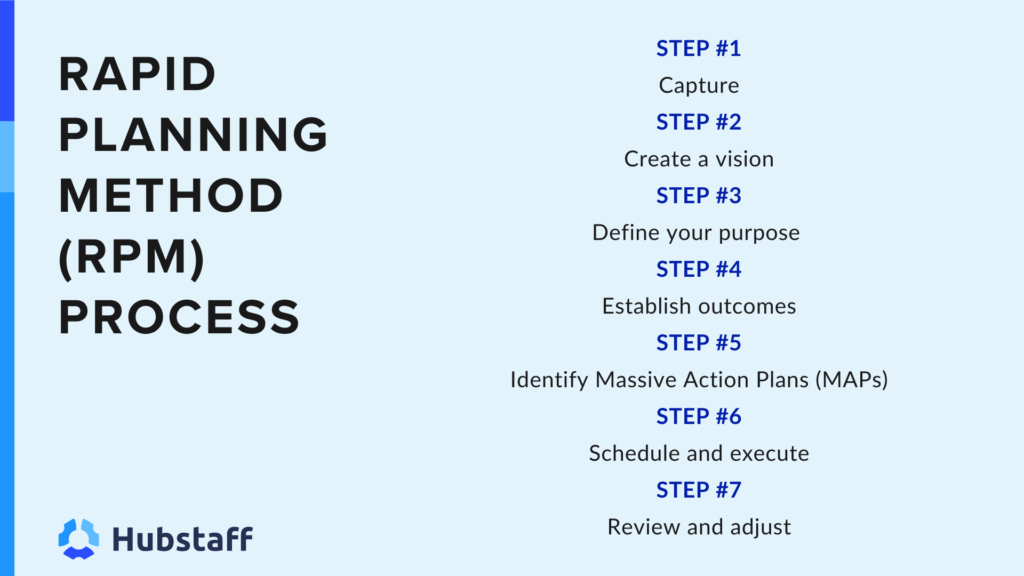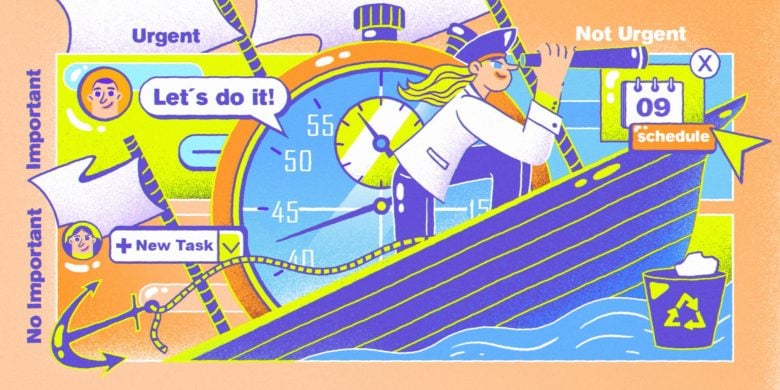Amid the crowded field of productivity hacks, the Rapid Planning Method (RPM) emerges as a game-changer with a twist. Developed by renowned life coach Tony Robbins, RPM is more than just another time management technique — it’s a way to reframe how we think about our goals.
At its core, RPM revolves around three fundamental principles:
- Focusing on outcomes instead of tasks
- Leveraging a sense of purpose
- Creating a massive action plan.
What sets RPM apart is its emphasis on clarity and purpose, turning mundane to-do lists into a roadmap for achieving meaningful goals. Imagine boosting your productivity while feeling a stronger sense of direction and fulfillment. That’s the goal of RPM.
At Hubstaff, we’re always eager to explore new ways to increase our productivity. I tried this method and am here to give you a first-hand review of how it worked. The number one thing I found is that implementing RPM is easier with tools and resources designed to guide you through the process. Today, I’ll give you the information and tools you need to make RPM work for you.
Boost your team’s efficiency with Hubstaff's productivity tools
Core principles of the Rapid Planning Method
The Rapid Planning Method is grounded in three foundational principles: being result-oriented, purpose-driven, and creating a massive action plan.
According to its creator, Tony Robbins, the Rapid Planning Method is more a system of thinking than just a time management technique. While trying this way of thinking out, I found this straightforward framework easy to follow and understand.

Let’s break these principles down and look into why they help you meet your goals.
1. Result-oriented
At the heart of RPM is a focus on outcomes rather than tasks. This principle emphasizes the importance of clearly defining what you want to achieve. Instead of getting bogged down by an endless to-do list, RPM encourages you to start with the end in mind.
For me, this meant thinking of my OKRs and KPIs rather than getting caught up in individual tasks. The way the RPM system shifts your perspective helped me ensure that my efforts were directed toward meaningful and impactful goals.
2. Purpose-driven
The second core principle of the RPM plan is being purpose-driven. This principle highlights the importance of understanding why you want to achieve a desired result. Connecting your goals to a deeper purpose infuses your actions with meaning and passion.
This intrinsic motivation helped me sustain my efforts — especially when faced with challenges or setbacks. This mindset made it easier to navigate the complexities of achieving my bigger goals.
3. Massive action plan
The final principle is creating a massive action plan. This means breaking down goals into actionable steps. A massive action plan ensures that you have a clear roadmap detailing the specific actions required to reach your desired outcomes.
These principles come together to form the Rapid Planning Method, a structured yet flexible way to boost your productivity beyond what traditional time management skills can achieve.
The Rapid Planning Method process: A step-by-step guide
Implementing the RPM system involves a structured approach designed to maximize productivity and achieve meaningful goals.
Here’s a detailed breakdown of the RPM process and how to implement it step-by-step:

Step 1: Capture
Objective: Gather all your thoughts, ideas, and tasks.
Method: Jot down everything on your mind using a notebook, digital tool, or whiteboard. This step helps clear mental clutter and ensures nothing is overlooked.
Action: Write down all your goals, tasks, ideas, and projects, whether big or small.
Step 2: Create a vision
Objective: Define your long-term vision for each area of your life.
Method: Envision what you want to achieve in various aspects of your life (this includes any goals in your personal and professional life).
Action: Describe what success looks like in each area. Be specific and inspiring to create a compelling vision that motivates you.
Step 3: Define your purpose
Objective: Understand why each goal or outcome is important to you.
Method: For each vision, identify the deeper purpose behind it. This helps align your goals with your values and passions.
Action: Write down why achieving each vision matters to you. This purpose will fuel your motivation and commitment.
Step 4: Establish outcomes
Objective: Set precise, specific results you want to achieve.
Method: Transform your visions into tangible outcomes. Ensure they are specific, measurable, and time-bound.
Action: Define the outcomes you need to achieve to realize your vision. For example, instead of “be more creative,” specify “create one new piece of art each week.”
Step 5: Identify Massive Action Plans (MAPs)
Objective: Develop a detailed plan of action for each outcome.
Method: Break down each outcome into actionable steps and prioritize them.
Action: Create a step-by-step plan outlining the specific actions you must take to achieve each outcome. Prioritize tasks based on their impact and urgency.
Step 6: Schedule and execute
Objective: Integrate your action plans into your daily and weekly schedules.
Action: Schedule your tasks and stick to the plan. Focus on executing your highest priority actions first.
Step 7: Review and adjust
Objective: Regularly assess your progress and make necessary adjustments.
Method: Set aside time weekly and monthly to review your outcomes, action plans, and overall progress.
Action: Reflect on what’s working and what isn’t. Adjust your plans as needed to stay on track toward your goals. Celebrate your successes and learn from any setbacks.
Example of a Rapid Planning Method process
I tried out the RPM process to organize my thoughts and goals using my existing OKRs.
Here’s a brief example of what using the rapid planning method looked like for me:
Step 1: Capture
At Hubstaff, we’re all about using OKRs and KPIs to organize our company-wide goals, so I was a few steps ahead of the game for the RPM process. I used existing documentation and Hubstaff Tasks to capture my goals quickly.

Step 2: Create a vision
My vision: Create high-quality, engaging content that drives user engagement and supports business goals.
Step 3: Define your purpose
My purpose: To enhance the company’s brand presence, educate the audience about our product, and generate leads through compelling content.
Step 4: Establish outcomes
Outcome: Create high-quality blog posts
Step 5: Identify Massive Action Plan
Action steps:
- Identify key topics and keywords that resonate with our target audience.
- Write and publish two blog posts per week.
- Optimize blog posts for SEO, including keyword integration and meta descriptions.
Step 6: Schedule and execute
Allocate specific times each day for writing, research, and collaboration with other departments.

Use project management tools like Asana or Trello to track tasks and deadlines.
Prioritize tasks based on their impact on the company’s content strategy and marketing goals.
Step 7: Review and adjust
As a content team, we meet weekly on a Sprint call to review progress. We gather metrics on content performance, like website traffic and lead generation. Then, we adjust the content strategy and action steps based on performance data and feedback from stakeholders.
My takeaway: I really liked using the Rapid Planning Method alongside other time management strategies. With RPM, I was able to align my efforts with the company’s goals, produce high-quality content, and keep big-picture goals in mind while working on my daily tasks.
The benefits of using the Rapid Planning Method
RPM is designed to help you clearly understand what you want to achieve, know why it’s essential, and create a robust plan to make it happen. But what makes RPM stand out in the crowded field of productivity hacks?
Here’s what I found when I used the RPM to organize my goals and thoughts while working:
- Increased productivity. Focusing on the big picture rather than individual tasks ensured that my efforts were directed toward meaningful goals. I felt that this boosted my overall productivity.
- Enhanced goal achievement. By clearly defining my goals and creating detailed action plans, I increased my chances of achieving them effectively.
- Greater clarity and focus. The RPM method helped me clarify what I want to achieve and why, providing a clear roadmap and eliminating distractions.
- Flexibility and adaptability. The method encourages regular review and adjustment of plans, making it easier to adapt to changes and stay on track.
Incorporating the Rapid Planning Method into your daily routine isn’t just about getting more done — it’s about getting the right things done with greater clarity, purpose, and efficiency.
Tools and resources for Rapid Planning Method
Implementing the RPM system can significantly enhance productivity with the right tools and resources.
Here are some recommendations to help you get started and stay on track:
- Tony Robbins RPM planner. Our friend Tony has made a tool specifically designed for the RPM method. This planner guides you through the process of capturing your thoughts, setting goals, and planning actions.
- Hubstaff. I used our workforce management software to help me track how I spend my time on tasks and projects and set goals. Hubstaff helps ensure that you execute action plans efficiently and are able to analyze where adjustments may be needed.

- Calendar apps. Use apps like Google Calendar or Apple Calendar to schedule your action steps and keep track of deadlines. Sync them with your digital planning tools for seamless integration.
- Mind mapping tools. Software like MindMeister or XMind can help you visually organize your thoughts and plans which makes capturing and structuring your ideas easier.
- Habit tracking apps. Tools like Habitica or Streaks can help you build and maintain the habits necessary to stay consistent with your RPM plans.
By leveraging these tools and resources, you can streamline the process of implementing RPM and maximize its effectiveness in your journey toward achieving your goals.
By focusing on a clear desired outcome, understanding the deeper reasons behind your goals, and crafting detailed action plans, RPM offers a holistic approach to productivity that can transform the way you work and live.
If you’re looking to focus on personal and professional growth, the benefits of RPM are clear. So, it’s time to give it a try and see how this powerful method can help you achieve your most ambitious goals.
Most popular
The Fundamentals of Employee Goal Setting
Employee goal setting is crucial for reaching broader business goals, but a lot of us struggle to know where to start. American...
Data-Driven Productivity with Hubstaff Insights: Webinar Recap
In our recent webinar, the product team provided a deep overview of the Hubstaff Insights add-on, a powerful productivity measurem...
The Critical Role of Employee Monitoring and Workplace Security
Why do we need employee monitoring and workplace security? Companies had to adapt fast when the world shifted to remote work...
15 Ways to Use AI in the Workforce
Whether through AI-powered project management, strategic planning, or simply automating simple admin work, we’ve seen a dramatic...




